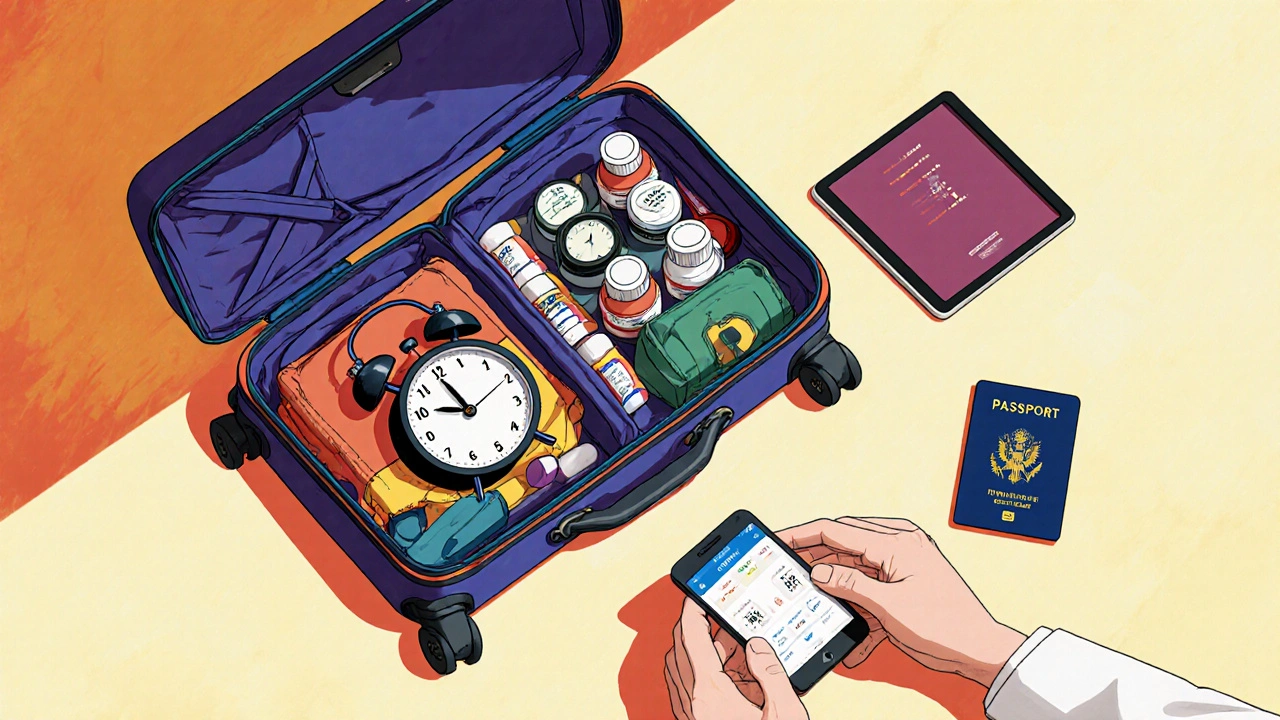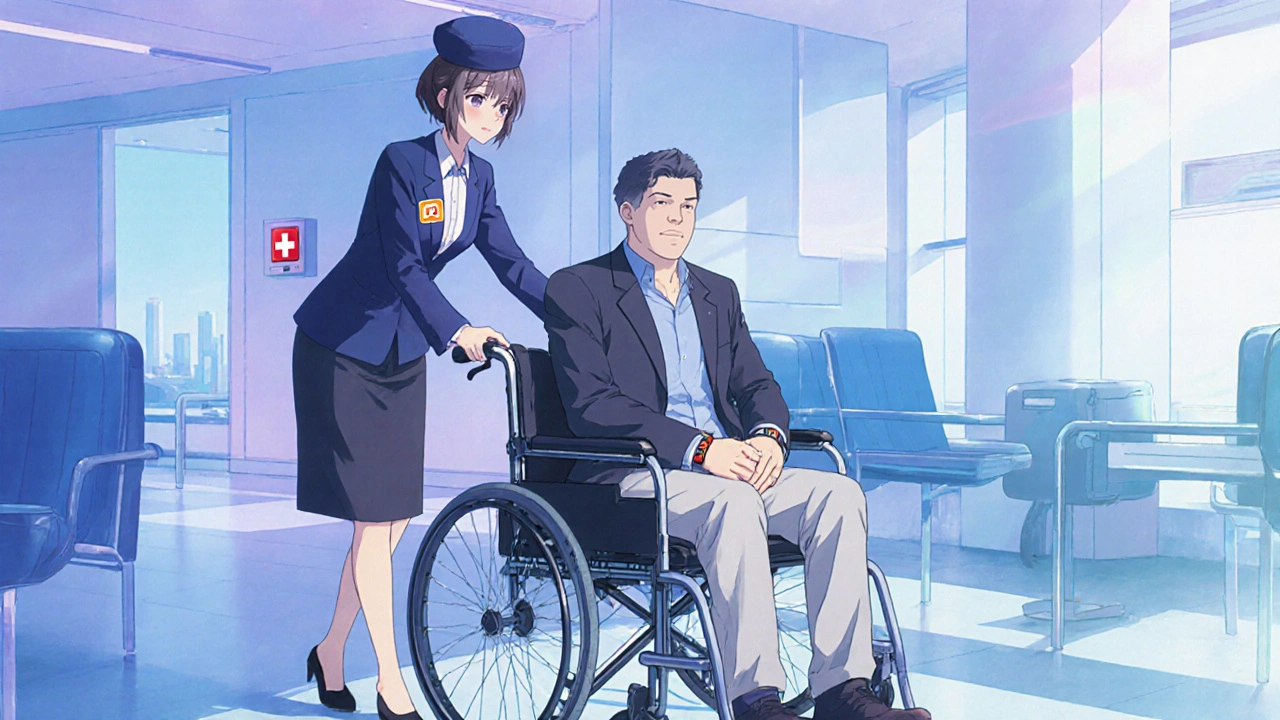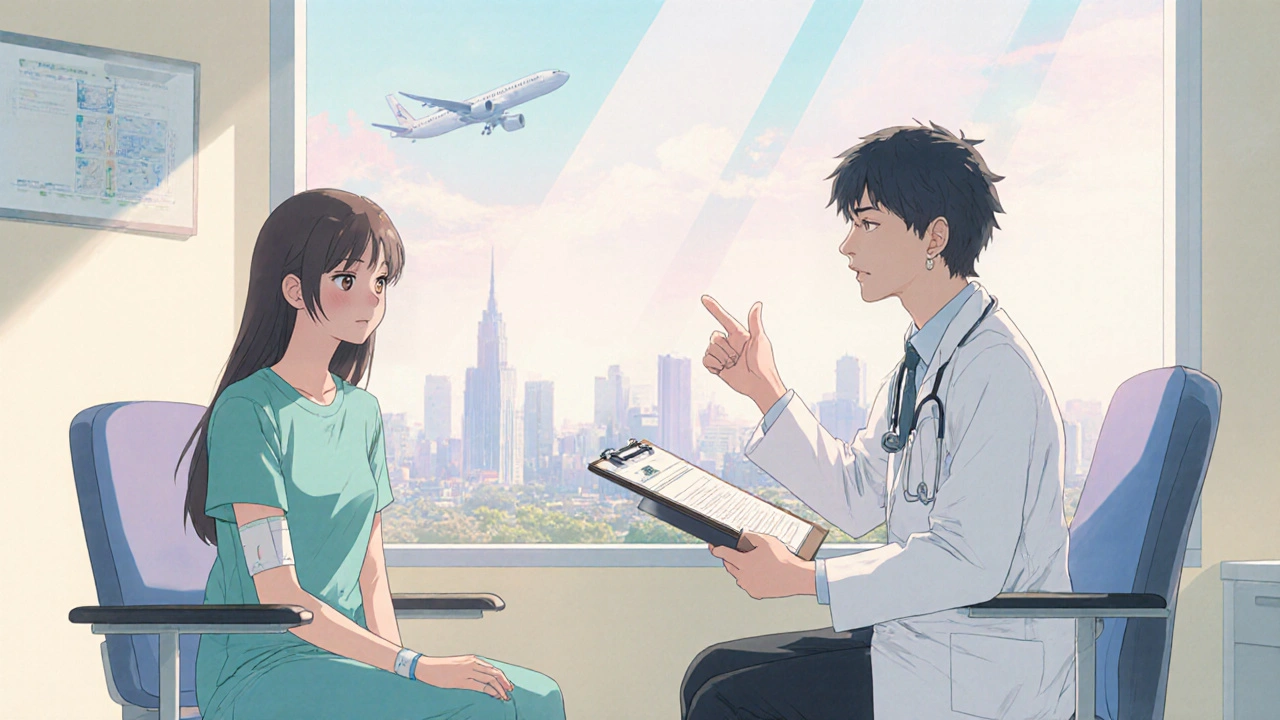Pancreatic Cancer Travel Safety Assessment
This assessment helps determine if your upcoming travel is safe given your pancreatic cancer treatment status. Answer the questions below to receive personalized recommendations.
Based on information from Canadian Cancer Society guidelines.
Travel Safety Assessment Result
RISK LEVELKey Recommendations
Additional Considerations
Why traveling with pancreatic cancer feels different
When dealing with Pancreatic cancer is a malignant disease of the pancreas that often requires complex treatment and ongoing monitoring, the idea of a trip-whether for a family visit, a vacation, or a second‑opinion appointment-can trigger a flood of worries. You might wonder how to keep treatments on schedule, manage side effects on the road, and stay safe in an unfamiliar place. This guide tackles those concerns step by step, turning anxiety into an actionable plan.
Get medical clearance before you book anything
The first move is a conversation with your Oncologist the doctor who oversees cancer treatment and can advise on travel suitability. Ask about:
- Current health status and any red‑flag symptoms that would make travel risky.
- Whether you need a written medical clearance letter for airlines or insurance.
- Adjustments to medication timing because of time‑zone changes.
Most specialists appreciate a clear itinerary and will help you decide if a short trip is feasible or if you should postpone until after the next treatment cycle.
Build a medication schedule that survives time zones
Pancreatic cancer regimens often involve oral chemotherapy, pain meds, and supplements. Create a pancreatic cancer travel tips checklist that lists each drug, dose, and the exact time you take it. Then:
- Convert your home‑time schedule to the destination’s local time.
- Set phone alarms, not just at the destination but also before you leave, to avoid missed doses.
- Pack a backup supply in a separate bag in case luggage is delayed.
Carry a printed medication list and a copy of your prescription-some countries require proof for controlled substances.
Choose the right travel insurance
Standard travel policies often exclude pre‑existing conditions, so you need a plan that specifically covers cancer‑related care. The table below compares three popular options that accept pancreatic cancer patients.
| Provider | Coverage Limit | Pre‑Existing Condition Clause | Medical Evacuation | Annual Premium (CAD) |
|---|---|---|---|---|
| SecureTrip | $250,000 | Covered after 90‑day waiting period | Included | $180 |
| GlobeAssist | $500,000 | Immediate coverage with medical clearance letter | Included | $245 |
| HealthVoyager | $300,000 | Covered after 60‑day waiting period | Optional (extra $30) | $210 |
Read the fine print carefully-some plans cap chemotherapy reimbursements or require you to notify them within 24 hours of a hospital visit.

Prepare documentation and emergency tools
Besides your insurance policy, gather a travel health folder that includes:
- Medical clearance letter from your Oncologist.
- Latest imaging reports and blood work (PDF format works well).
- List of allergies and a contact sheet for your primary care team.
- Contact details for the nearest Hospital a medical facility equipped to handle oncology emergencies at your destination.
Consider wearing a medical alert bracelet that states “Pancreatic cancer - requires immediate medical attention” in both English and the local language.
Transport and airport assistance
Many airlines offer special assistance for passengers with medical conditions. When you book, request:
- Wheelchair support from check‑in to boarding.
- Seat near the aisle for easier bathroom access.
- Pre‑boarding to settle your medication kit without rush.
If you anticipate a long layover, ask the airline about a quiet lounge or a place to store temperature‑sensitive meds.
Stay hydrated, manage side effects on the go
Side effects like nausea, fatigue, and dry mouth are common during chemotherapy. Simple habits help:
- Drink water regularly-aim for at least 2 liters per day.
- Carry ginger chews or anti‑nausea patches (check local regulations).
- Plan rest breaks every 2-3 hours during road trips.
- Use sunscreen-some pancreatic cancer treatments increase skin sensitivity.
These tweaks keep you comfortable without turning the trip into a medical chore.

Build a support network at your destination
Even if you’re traveling alone, you don’t have to go it solo. Identify local resources before you leave:
- Patient advocacy groups that meet in the city-many have online calendars.
- Hospitals with an oncology department; ask if they have a patient liaison.
- Friends or relatives who can check in daily, even via a quick text.
Knowing who to call when you feel off‑track reduces anxiety and speeds up help if something goes wrong.
Checklist for a smooth journey
- Confirm medical clearance and obtain a signed letter.
- Purchase travel insurance that covers pre‑existing conditions.
- Pack a medication kit with backups, a printed schedule, and a copy of prescriptions.
- Assemble a health folder with reports, allergy list, and local hospital contacts.
- Wear a medical alert bracelet.
- Notify the airline of special assistance needs.
- Bring hydration supplies and side‑effect relief items.
- Identify a local support network.
Run through the list a day before departure; crossing items off feels reassuring and ensures nothing crucial gets left behind.
What to do if an emergency arises abroad
Even with meticulous planning, emergencies happen. Follow this quick protocol:
- Call local emergency services (e.g., 911 in the U.S., 112 in Europe).
- Show your medical alert bracelet and hand over the health folder.
- Inform the hospital that you have pancreatic cancer and provide recent treatment details.
- Contact your travel insurance provider within the required window to trigger coverage.
- Notify a family member back home-keep a list of contacts in your phone.
Having a clear, rehearsed plan reduces panic and ensures you get the right care quickly.
Can I fly with a port‑site infusion pump?
Yes, most airlines allow medical devices if you bring a doctor’s note and the pump is battery‑powered. Notify the airline during booking and request a seat with extra legroom for easier access.
Do I need a visa for medical travel?
Visa requirements depend on the destination and the purpose of stay. If the trip is for treatment, many countries offer a medical‑tourism visa that shortens processing time. Check the embassy website well before you leave.
How can I keep my chemotherapy cold chain while traveling?
Use a portable cooler with ice packs approved for medical transport. Keep the temperature log and inform the airline’s cargo department that the package contains temperature‑sensitive medication.
What if my side effects worsen during the trip?
Contact the local hospital’s oncology department immediately. Having your health folder and a translated summary of your treatment plan speeds up care. If needed, your travel insurance can cover an unexpected return flight.
Is it safe to eat local food while on chemotherapy?
Stick to well‑cooked meals and avoid raw seafood, unpasteurized dairy, and street‑food salads that might harbor bacteria. When in doubt, ask the restaurant about food preparation practices.

14 Comments
Sure, the guide sounds like a polished sales pitch for travel agencies that love premium insurance plans.
What most people forget is that most pancreatic cancer patients can’t afford the extra $200 they’re being coaxed into paying.
Medical clearance letters are often a bureaucratic dance that delays treatment rather than enabling it.
If you’re lucky enough to get a clear letter, you’ll still find airlines charging for wheelchair assistance without any real help.
Packing a backup medication kit sounds sensible until you realize customs in some countries will confiscate any suspicious pill bottles.
The whole “temperature‑sensitive chain” advice is a nightmare if you’re traveling through multiple time zones on a budget.
You’re told to wear a medical alert bracelet, but a simple sticker on your suitcase can serve the same purpose without attracting unwanted attention.
Most hospitals abroad don’t speak English, so the translated summary you bring is often ignored.
The table comparing insurance plans is neat, yet it hides the fact that the fine print can void coverage after the first claim.
Travel insurance that covers pre‑existing conditions is practically a myth in many jurisdictions.
Relying on a private insurer for emergency evacuation is risky when your home country’s health system can repatriate you faster.
The checklist at the end feels like a homework assignment for someone who already knows how to survive a cruise.
In reality, the biggest hurdle is mental fatigue, not a missing dosage or a lost passport.
If you can keep a positive mindset, most of the bureaucratic obstacles melt away.
So before you spend hours cross‑checking tables, ask yourself if the trip is truly necessary or just a distraction.
Sometimes staying home and focusing on treatment is the safest travel plan of all.
Oh, great, another glossy guide that assumes everyone has a personal assistant to handle insurance paperwork.
I love how it pretends that a simple bracelet can replace a full‑blown medical team.
The “quick protocol” for emergencies sounds like a meme you’d share when you’ve never actually needed it.
Sure, let’s all ignore the fact that most of us can’t even afford the suggested insurance premiums.
Medical clearance is non‑negotiable; schedule it before booking any flight.
One must appreciate the meticulousness of this checklist; it elevates travel preparation to an art form.
The elegance lies in its systematic approach, turning chaos into curated order.
It’s akin to curating a fine wine list-each element selected with discerning taste.
Honestly, the guide feels like a philosophical essay on mortality disguised as a travel brochure 🤔.
It’s poetic, yet the practical bits get lost in the labyrinth of lofty prose.
Still, kudos for reminding us that life’s journey is both a roadtrip and a meditation 🌌.
Embarking on a journey with pancreatic cancer isn’t just a trip-it’s a bold statement of resilience painted across continents.
Harness that inner fire, pack those meds like treasures, and let every airport lounge become a pit stop of empowerment.
Your adventure can be a kaleidoscope of hope, courage, and unstoppable determination.
It is advisable to pre‑arrange airport assistance well in advance, ensuring that wheelchair services are confirmed and medication storage complies with airline regulations.
Additionally, maintaining a duplicate set of prescriptions in a separate compartment mitigates the risk of loss during transit.
Yo, don’t just skim the checklist-own it.
Set alarms on every device, double‑check the dosage times after each timezone shift, and keep that cooler packed like a pro.
If anything feels off, call the local oncologist ASAP; no excuses.
The whole “insurance covers everything” narrative is a smokescreen manufactured by big pharma to keep us dependent on their policies.
Remember, most emergency evacuations are delayed because the airline crew won’t prioritize a “cancer patient” without a hefty surcharge.
Every step you take on foreign soil is a silent dialogue with the universe, affirming that vulnerability can coexist with strength.
Embrace the unknown as a teacher, and let each sunrise remind you that healing is as much a mental pilgrimage as a physical one.
Listen, the guide forgets that most of us can’t even afford the “premium” insurance they brag about-it's a total rip‑off.
And the whole “backup meds in a separate bag” tip? Ha! Airlines love to confiscate anything that looks like a drug, especially if it's not in a clear plastic pouch.
So you might end up in a foreign ER with nothing but a sticky note.
Traveling with cancer is tough, but planning makes it doable.
The document is saturated with buzz‑words and filler phrases that add no actionable value, essentially a corporate PR piece masquerading as patient guidance.
Its overreliance on insurance jargon obscures the real logistical challenges, leaving readers with a false sense of security.
Wow, another “comprehensive” guide that pretends to know every nuance of oncology travel, yet it glosses over the fact that most patients can’t even secure a simple airline seat without a marathon of paperwork.
Nice try, but the reality is far messier.
Write a comment